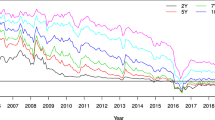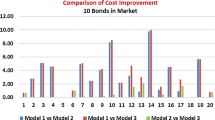Abstract
The minimum (worst case) value of a long-only portfolio of bonds, over a convex set of yield curves and spreads, can be estimated by its sensitivities to the points on the yield curve. We show that sensitivity based estimates are conservative, i.e., underestimate the worst case value, and that the exact worst case value can be found by solving a tractable convex optimization problem. We then show how to construct a long-only bond portfolio that includes the worst case value in its objective or as a constraint, using convex–concave saddle point optimization.





Similar content being viewed by others
Data availability
The data used to reproduce our results is available at https://github.com/cvxgrp/robust_bond_portfolio.
References
Bloomberg. Bloomberg fixed income indices fact sheets and publications, Nov. 16, 2022 [Online]
Boyd, S., Busseti, E., Diamond, S., Kahn, R., Koh, K., Nystrup, P., Speth, J.: Multi-period trading via convex optimization. Found. Trends Optim. 3(1), 1–76 (2017)
Boyd, S., Vandenberghe, L.: Convex Optimization. Cambridge University Press, Cambridge (2004)
Bredies, K., Sun, H.: Accelerated Douglas-Rachford methods for the solution of convex-concave saddle-point problems. arXiv preprint arXiv:1604.06282, (2016)
Cochrane, J., Piazzesi, M.: Bond risk premia. Am. Econ. Rev. 95(1), 138–160 (2005)
Diamond, S., Boyd, S.: CVXPY: a python-embedded modeling language for convex optimization. J. Mach. Learn. Res. 17(1), 2909–2913 (2016)
Elton, E., Gruber, M., Brown, S., Goetzmann, W.: Modern Portfolio Theory and Investment Analysis. Wiley, New York (2009)
Fabozzi, F., Mann, S.: The Handbook of Fixed Income Securities. McGraw-Hill Education, New York (2012)
Federal Reserve Bank of St. Louis. Data: [BAMLC0A1CAAA, BAMLC0A2CAA, BAMLC0A3CA, BAMLC0A4CBBB], Nov. 16, 2022 [Online]
Filipović, D., Pelger, M., Ye, Y.: Stripping the discount curve-a robust machine learning approach. Swiss Finance Institute Research Paper, (22–24), (2022)
Fu, A., Narasimhan, B., Boyd, S.: CVXR: an R package for disciplined convex optimization. J. Stat. Softw. 94(14), 1–34 (2020)
Grant, M., Boyd, S.: CVX: Matlab software for disciplined convex programming, version 2.1. (2014)
Grant, M., Boyd, S., Ye, Y.: Disciplined Convex Programming. Springer, US, Boston, MA (2006)
Juditsky, A., Nemirovski, A.: On well-structured convex-concave saddle point problems and variational inequalities with monotone operators. Optim. Methods Softw. 37(5), 1567 (2021)
Kim, J., Kim, W., Fabozzi, F.: Recent developments in robust portfolios with a worst-case approach. J. Optim. Theory Appl. 161(1), 103–121 (2014)
Korn, O., Koziol, C.: Bond portfolio optimization: a risk-return approach. J. Fixed Income 15(4), 48–60 (2006)
Litterman, R., Scheinkman, J.: Common factors affecting bond returns. J. Fixed Income 1(1), 54–61 (1991)
Markowitz, H.: Portfolio selection. J. Finance 7, 77–91 (1952)
Nemirovski, A.: Prox-method with rate of convergence \(o(1/t)\) for variational inequalities with Lipschitz continuous monotone operators and smooth convex-concave saddle point problems. SIAM J. Optim. 15(1), 229–251 (2004)
Nemirovski, A., Yudin, D.: Cesari convergence of the gradient method of approximating saddle points of convex-concave functions. Doklady Akademii Nauk 239, 1056–1059 (1978)
Nemirovski, A., Yudin, D.: Problem Complexity and Method Efficiency in Optimization. Wiley-Interscience, Hoboken (1983)
Puhle, M.: Bond Portfolio Optimization, vol. 605. Springer, Berlin (2008)
Schiele, P., Luxenberg, E., Boyd, S.: Disciplined saddle point programming. arXiv preprint arXiv:2301.13427, (2023)
Sion, M.: On general minimax theorems. Pac. J. Math. 8(1), 171–176 (1958)
Tütüncü, R., Koenig, M.: Robust asset allocation. Ann. Oper. Res. 132(1), 157–187 (2004)
Udell, M., Mohan, K., Zeng, D., Hong, J., Diamond, S., Boyd, S.: Convex optimization in Julia. In: SC14 Workshop on High Performance Technical Computing in Dynamic Languages (2014)
U.S. Department of the Treasury. Daily treasury par yield curve rates, Nov. 16, (2022) [Online]
Von Neumann, J.: Zur Theorie der Gesellschaftsspiele. Mathematische Annalen 100(1), 295–320 (1928)
Von Neumann, J., Morgenstern, O.: Theory of Games and Economic Behavior. Princeton University Press, Princeton (1953)
Acknowledgements
We thank Dr. Baruch Gliksberg for his thoughtful comments and suggestions. This research was partially supported by ACCESS (AI Chip Center for Emerging Smart Systems), sponsored by InnoHK funding, Hong Kong SAR, and by ONR N000142212121. P. Schiele is supported by a fellowship within the IFI program of the German Academic Exchange Service (DAAD).
Author information
Authors and Affiliations
Corresponding author
Additional information
Communicated by Wei Bian.
Publisher's Note
Springer Nature remains neutral with regard to jurisdictional claims in published maps and institutional affiliations.
Appendices
Worst Case Analysis CVXPY Code

Explicit Dual Portfolio Construction CVXPY Code

Derivation of Dual Form
We now derive the dual form of the worst case portfolio construction problem for the case where the uncertainty set in polyhedral. We note that the worst case \(\log \) change in portfolio value for a fixed h, \(\varDelta ^\text {wc}(h)\) is given by the optimal value of the optimization problem
We have written this problem with (y, s) explicitly, instead of with x, to emphasize the objective’s dependence on each component. We note that due to our budget constraint, \( \log (V(y,s))=\log (p^Th)\).
In order to obtain a closed form dual, we introduce a new variable \(z\in {\text{ R }}^{nT}\), where we think of \(z_{i,t}\) as corresponding to \( y_t+ s_i\). This is a very general formulation which allows each bond to be associated with its own yield curve \(y_i\in {\text{ R }}^T\), with \(z_{i,t}\) corresponding to the t’th entry of the i’th bond’s yield curve. Since we model each bond as having its own yield curve, this formulation generalizes the earlier treatment with yields and spreads handled separately. We can recover the original structure with the linear constraints
which are representable as \(z=Fx\) for an appropriate \(F\in {\text{ R }}^{nT\times (T+n)}\). As such, the problem is equivalent to
Strong duality tells us that \(\varDelta ^\text {wc}(h)\) is equal to the optimal value of the dual problem of (17) [3, §5.2].
Dual Problem We derive the dual of the problem
First, with f the log-sum-exp function \(f(x)=\log \left( \sum \exp x_i\right) \), we observe that our problem can be rewritten as
We define C to be the diagonal matrix with \(C_{i,t}=-t\), where we are using unwound vectorized indexing for z, and \(d\in {\text{ R }}^{nT}\) to be the vector with \(d_{i,t} = \log (c_{i,t}h_i)\). Then, the Lagrangian is given by
The Lagrange dual function is given by
The second term is equal to \(-\infty \) unless \(A^T\mu +F^T\nu =0\), so this condition will implicitly restrict the domain of g. Now, note that with \(g(z)=f(Cz+d)\), the first term can be rewritten as
where \(g^*(y)=\max {y}y^Tz-g(z)\) is the conjugate of g. [3, §3.3.1].
We now use two facts from [3, §3.3.2]. First, in general the conjugate of the linear precomposition \(\phi (z)=\rho (Cz+d)\) can be written in terms of the conjugate of \(\rho \) as \(\phi ^*(y) = \rho ^*(C^{-T}y)-d^TC^{-T}y\). Second, the dual of the log-sum-exp function f is
Combining these two facts, and expanding terms, we find that
with
Thus the robust bond portfolio problem can be written as
where we have moved the implicit constraints in the definition of g to explicit constraints in the optimization problem. Note this equivalent optimization problem has new variables \(\mu \) and \(\nu \). By using that \(-\lambda \max _{\mu ,\nu }g(\mu ,\nu )= \min _{\mu ,\nu }-\lambda g(\mu ,\nu )\) and collecting the minimization over h, \(\mu \), and \(\nu \), we obtain the form in Sect. 5.2.
Rights and permissions
Springer Nature or its licensor (e.g. a society or other partner) holds exclusive rights to this article under a publishing agreement with the author(s) or other rightsholder(s); author self-archiving of the accepted manuscript version of this article is solely governed by the terms of such publishing agreement and applicable law.
About this article
Cite this article
Luxenberg, E., Schiele, P. & Boyd, S. Robust Bond Portfolio Construction via Convex–Concave Saddle Point Optimization. J Optim Theory Appl (2024). https://doi.org/10.1007/s10957-024-02436-z
Received:
Accepted:
Published:
DOI: https://doi.org/10.1007/s10957-024-02436-z




